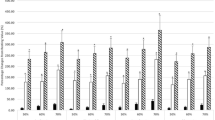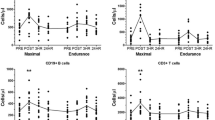Abstract
To study the effects of exercise on circulating leukocytes and leukocyte subsets, physically active (n = 32) and sedentary (n = 32) male and female subjects were randomly assigned to an exercise or control condition. Exercise involved a continuous incremental protocol consisting of cycling for three periods of 6 min at power outputs corresponding to 55%, 70% and 85% maximal oxygen uptake (\(\dot V{\text{O}}_{{\text{2max}}}\). Blood samples were drawn from a venous catheter at baseline, and at 6 min, 12 min, and 18 min after beginning the exercise and 2 h following completion of exercise. Resting- and exercise-induced alterations in total leukocytes were independent of gender and subject fitness level. Relative to baseline, each increment in workload resulted in a rapid increase in the number of circulating leukocytes. Increases in neutrophils, lymphocytes and monocytes accounted for the exercise-induced leukocytosis. With regard to lymphocytes, exercise resulted in a significant increase in the number of T cells (CD3+), T helper cells (CD4+), T suppresser (CD8+) and natural killer (NK) cells (CD3−/CD16+/CD56+). The largest percentage increase occurred in the NK cell population. The CD4+: CD8+ ratio decreased (P < 0.001) throughout exercise due to a larger increase in the number of CD8+ cells relative to CD4+ cells. An exercise-induced neutrophilia, lymphocytopenia, and eosinophelia was observed 2 h into recovery. Exercise resulted in significant increases in plasma epinephrine and norepinephrine levels. There was no indication of a hypothalamic-pituitarty-adrenal response during exercise. The results indicate that the rapid, albeit transient, alteration in the number of circulating leukocytes during and following an acute progressive incremental exercise test are independent of gender and fitness.
Similar content being viewed by others
References
Ashmed SA, Penhale WJ, Talal N (1985) Sex hormones, immune responses and autoimmune diseases. Am J Pathol 121: 531–551
Benoti G, Bellavite P, Adami A, Chirumbolo S, Lippi G, Brocco G, Cuzzolin L (1995) Effects of acute exercise on some haematological parameters and neutrophil function in active and inactive subjects. Ear J Appl Physiol 70: 187–191
Benschop RJ, Oostveen FG, Heijnen CJ, Ballieux RE (1993) β2-Adrenergic stimulation causes detachment of natural killer cells from cultured endothelium. Ear J Immunol 23: 3243–3247
Berne RM, Levy MN (1993) Physiology. Mosby-Year Book, St. Louis, Mo.
Bjune G (1979) In vitro lymphocyte responses to PHA show covariation with the menstrual cycle. Scan J Immunol Abstr 10: 362
Brahmi Z, Thomas JE, Park M, Park M, Dowdeswell IRG (1985) The effect of acute exercise on natural killer-cell activity of trained and sedentary human subjects. J Clin Immunol 5: 321–329
Christensen LB (1991) Experimental methodology, 5th edn. Allyn and Bacon, Needham Heights, Mass.
Cupps TR, Fauci AS (1982) Cortocosteroid-mediated immunoregulation in man. Immunol Rev 65: 133–155
Dill D, Costill DL (1974) Calculation of percentage changes in volumes of blood, plasma, and red cells in dehydration. J Appl Physiol 37:247–248
Fujii N, Miyazaki H, Homma S, Ikegami H (1993) Dynamic exercise induces translocation of β2-adrenergic receptors in human lymphocytes. Acta Physiol Scand 148:463–464
Kappel M, Tvede N, Galbo H, Haahr PM, Kjaer M, Linstow M, Klarlund K, Pedersen BK (1991) Evidence that the effect of physical exercise on NK cell activity is mediated by epinephrine. J Appl Physiol 70: 2530–2534
Keast D, Morton AR (1992) Long term exercise and immune functions. In: Watson RR, Eisinger M (eds) Exercise and disease. CRC Press, Ann Arbor, pp 89–120
LaPerriere A, Antoni MH, Ironson G, Perry A, McCabe P, Klimas N, Helder L, Schneiderman N, Fletcher MA (1994) Effects of aerobic exercise training on lymphocyte subpopulations. Int J Sports Med 15:S127–5130
Loucks AB, Mortola JF, Girton L, Yen SSC (1989) Alterations in the hypothalamic-pituitary-ovarian and the hypothalamic-pituitary-adrenal axis in athletic women. J Clin Endocrinol Metab 68:402–411
Mackinnon LT (1992) Exercise and immunology. In: Current issues in exercise science series, monograph no. 2. Human Kinetics, Champaign, Ill.
Maki T, Kontula K, Harkoinen M (1990) The beta-adrenergic system in man: physiological and pathophysiological response. Scand J Clin Lab Invest 50:S201:25–43
Mathur S, Mathur RS, Goust JM, Williamson HO, Fudenberg HH (1979) Cyclic variations in white cell populations in the human menstrual cycle: correlations with progesterone and estradiol. Clin Immunol Immunopathol 13:246–253
McCarthy DA, Dale MM (1988) The leukocytosis of exercise: a review of the model. Sports Med 6:333–363
Michaels RH, Rogers KD (1971) A sex difference in immune responsiveness. Pediatrics 47:120–123
Ndon JA, Snyder AC, Foster C, Wehrenberg WB (1991) Effects of chronic intense exercise training on the leukocyte response to acute exercise. Int J Sports Med 13:176–182
Nehlsen-Cannarella SL, Nieman DC, Balk-Lamberton AJ, Markoff PA, Chritton DWB, Gusewitch G, Lee JW (1991) The effect of moderate exercise on immune response. Med Sci Sports Exerc 23:64–70
Nieman DC (1994) Exercise, upper respiratory tract infection, and the immune system. Med Sci Sports Exerc 26:128–139
Nieman DC, Tan SA, Lee JW, Berk LS (1989) Complement and immunoglobulin levels in athletes and sedentary controls. Int J Sports Med 10:124–128
Nieman DC, Buckley KS, Henson DA, Warren BJ, Suttles J, Ahle JC, Simandle S, Fagoaga OR, Nehlsen-Cannarella SL (1995a) Immune function in marathon runners versus sedentary controls. Med Sci Sports Exerc 27:986–992
Nieman DC, Brendle B, Hensen DA, Suttles J, Cook VD, Warren BJ, Butterworth DE, Fagoaga OR, Nehlsen-Cannarella SL (1995b) Immune function in athletes versus nonathletes. Int J Sports Med 16:329–333
Rogal AD, Weltman JY, Evans WS, Veldhuis JD, Weltman AL (1992) Long term endurance training alters the hypothalamicpituitary axes for gonadotropins and growth hormone. Endocrinol Metab Clin North Am 21:817–832
Rhind SG, Shek PN, Shinkai S, Shephard RJ (1994) Differential expression of interleukin-2 receptor alpha and beta chains in relation to natural killer cell subsets and aerobic fitness. Int J Sports Med 6:911–918
Rhodes K, Scott A, Markhan RL, Monk-Jones ME (1969) Immunological sex differences. Ann Rheum Dis 28:104–119
Schedlowski M, Hosch W, Oberbeck R, Benschop RJ, Jacobs R, Raab HR, Schmidt RE (1996) Catecholamines modulate human NK cell circulation and function via spleen-independent β2-adrenergic mechanisms. J Immunol 156:93–99
Schuurs A, Verheul H (1990) Effects of gender and sex steroids on the immune response. J Steroid Biochem 35:157–172
Smith JA (1995) Guidelines, standards, and perceptives in exercise immunology. Med Sci Sports Exerc 27:497–506
Spencer MJ, Chery JD, Powell KR, Mickey MR, Terasaki PI, Mary SM, Sumaya CV (1977) Antibody responses following rubella immunisation analyzed by HLA and ABO types. Immunogenetics 4:365–372
Surkina ID, Gotovtseva EP (1989) The immune state of female athletes and its correlation with menstrual functions and conditions of sports activities. Sports Train Med Rehabil 1:85–88
Sutton JR, Farrell PA, Haraber VJ (1990) Hormonal adaptation to physical activity. In: Bouchard C (ed) Exercise, fitness, and health: a consensus of current knowledge. Human Kinetics Champaign, Ill., pp 217–257
Tomasi TB, Trudeau FB, Czerwinski D, Erredge S (1982) Immune parameters in athletes before and after strenuous exercise. J Clin Immunol 2:173–178
Tonnesen E, Christensen NJ, Brinklow MM (1987) Natural killer cell activity during cortisol and adrenaline infusion in healthy volunteers. Eur J Clin Invest 17:497–503
Van Tits LJH, Michel MC, Grosse-Wilde H, Happel M, Eigler FW, Soliman A, Brodde OE (1990) Catecholamines increase lymphocyte β2-adrenergic receptors via a β2-adrenergic, spleen-dependent process. Am J Physiol 258:E191-E202
Watson RR, Moriguchi S, Jackson JC, Werner L, Wilmore JH, Freund BJ (1986) Modification of cellular immune function in humans by endurance exercise training during B-adrenergic blockade with atenolol or propranolol. Med Sci Sports Exerc 18:95–100
Author information
Authors and Affiliations
Rights and permissions
About this article
Cite this article
Moyna, N.M., Acker, G.R., Weber, K.M. et al. The effects of incremental submaximal exercise on circulating leukocytes in physically active and sedentary males and females. Europ. J. Appl. Physiol. 74, 211–218 (1996). https://doi.org/10.1007/BF00377443
Accepted:
Issue Date:
DOI: https://doi.org/10.1007/BF00377443




